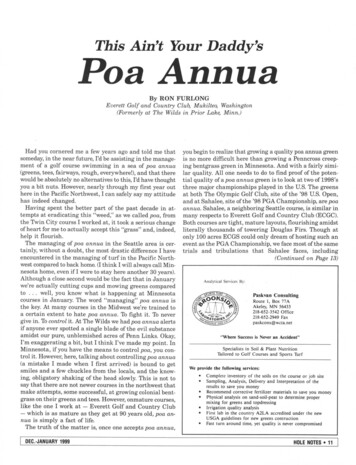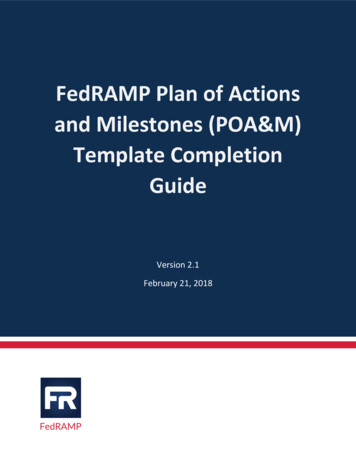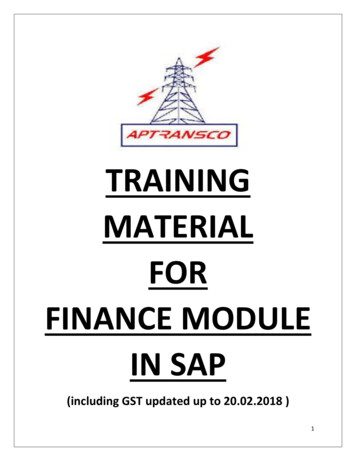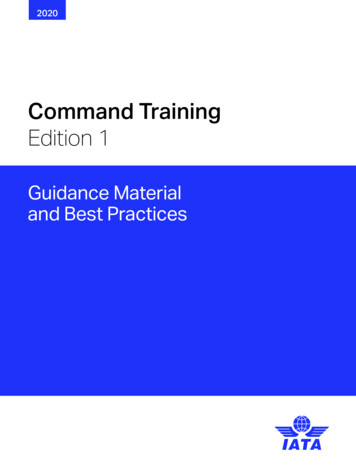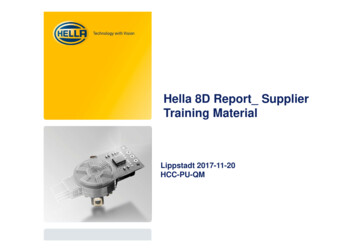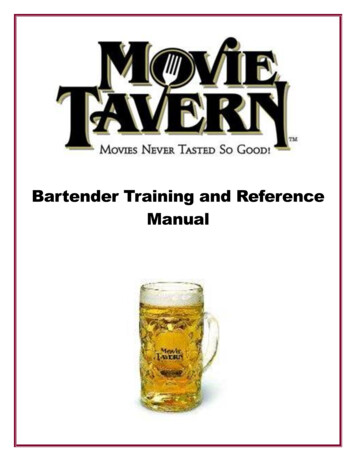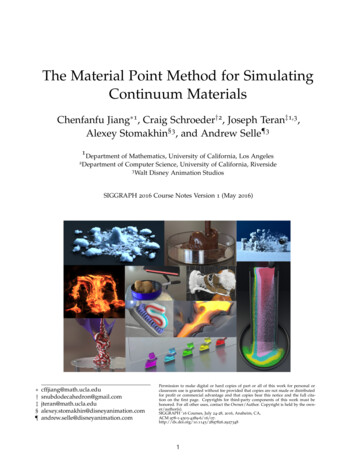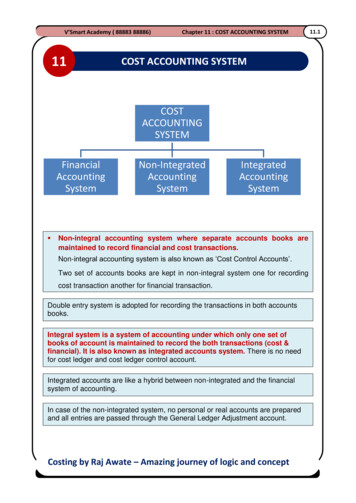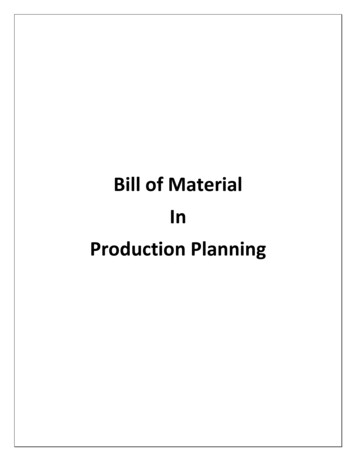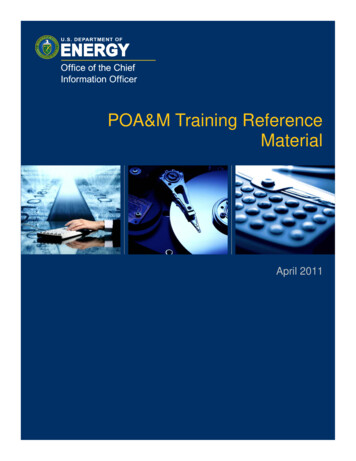
Transcription
POA&M Training ReferenceMaterialApril 20111
POA&M Training Reference MaterialApril 2011What is a POA&M? Plan of Actions and Milestones A POA&M is a management tool for trackingthe mitigation of cyber security program andsystem level findings/weaknesses.Sources of POA&Ms Where do POA&Ms come from? External findings (e.g., HSS, IG, GAO, Site Officereviews, etc.) Internal findings (e.g., In-house self-assessments,peer reviews, etc.) Certification & Accreditation (C&A) Activities (e.g.,Failed certification tests, etc.)2
POA&M Training Reference MaterialApril 2011What is not a POA&M? A POA&M is not an Action Tracking Plan. A POA&M is not a Corrective Action Plan, orCAP. CAP provides specific information as toremediation of findings/weaknesses. CAP includes a determination of causal factorsand trends.Corrective Action Plan, or CAP CAPs are required for all POA&Ms with correctiveactions that require more than one (1) year to complete. At a minimum, CAPS must include: Root cause analysis Mitigation/resolution alternatives and associated riskanalyses Recurrence prevention strategies CAPs for findings identified by HSS must comply withguidance established/directed by that organization. DOE O 470.2B, Independent Oversight andPerformance Assurance Program3
POA&M Training Reference MaterialApril 2011Suggested Content of CAP A brief overview and summary of the identified weakness/finding. Root cause analysis addressing any systematic programweaknesses. Description of mitigation/resolution strategies. Office or organization responsible for remediation. Resource requirements and expected costs. Scheduled start and completion date. At least one major milestone and completion date. Statement of risk assessment, acceptance, and approval. Statement of verification requirements to include responsibleindividual or office and documentation requirements.4
POA&M Training Reference MaterialApril 2011Drivers FISMA, Title III, Information Security OMB M-02-01, Guidance for Preparing and SubmittingSecurity Plans of Action and Milestones DOE O 205.1B, Department Cyber SecurityManagement Senior DOE Management PCSPs (if applicable)Business Purpose Effective Data Analysis – Consistent, aggregated informationis an effective management tool. Showcase systematic successes and problems. Snapshot of program and system level status. Assists with timely resolution of findings andprioritization of resources. Enhance C&A efforts. POA&M information impacts internal and congressionalscorecards. OMB requires Federal agencies to report all system andprogram deficiency information quarterly.5
POA&M Training Reference MaterialApril 2011Partnership OCIO is a partner in the POA&M process. The OCIO is a resource to assist with issues or questions. The OCIO is open to suggestions. You are welcome tocontact the OCIO directly if you have suggestions orquestions, but please coordinate communications withyour POC. You can benefit from information that the OCIO haslearned as a result of partnering with other organizationsinternal and external to DOE.6
POA&M Training Reference MaterialApril 2011Baseline Requirements A POA&M must be developed for each programand system level finding/weakness as identifiedby: Office of Health, Safety, and Security (HSS)General Accounting Office (GAO)Office of Inspector General (IG)Internal program and system reviews/selfassessments C&A ActivitiesBaseline Requirements Each POA&M and its associated milestone(s) must have ascheduled completion date that reflects a reasonable timeperiod for completion of a remediation activity.Findings/weaknesses identified by the GAO and IG aregenerally expected to be completed within 1 year.Reference DOE O 224.3, Audit Resolution and Follow-upProgram. Per OMB, changes cannot be made to the original descriptionof the finding/weakness, milestones, scheduled completiondates, or source. Exception to the rule does exist; seepage 8. Reported closure of the finding/weakness and/or milestonesmust be validated by independent party – not the individual(s)directly responsible for the closure.7
POA&M Training Reference MaterialApril 2011Baseline Requirements The following information must be reported on thePOA&M when a finding/weakness and/or milestone iscompleted: Name and title of individual performing verification Date of verification All completed milestones must be verified by anindependent before weakness closure. All completed findings/weaknesses must remain onPOA&M report for a period of 1 year from the date ofverification.Exception to the Rule Changes cannot be made to original POA&Mcontent unless: Changes are fully supported by documentation asrequired by the originating source (i.e., internal orexternal) of the finding/weakness. Changes mustbe coordinated with your specific Data Call POC. Detail of any changes must be noted in Commentcolumn.8
POA&M Training Reference MaterialApril 2011Program vs. System Level Program Level POA&M A program level finding/weakness addresses identifiedcyber security weaknesses or deficiencies that impact theentire cyber security program. For example, Lack of effective password policy across all platforms. Lack of formalized risk assessment process. Lack of approved PCSPProgram vs. System Level System Level POA&M A system level finding/weakness addresses an identifiedweakness associated with an information system with adefined accreditation boundary or a single System SecurityPlan (SSP). For example, System X does not comply with stated passwordcharacteristic requirements. No formal risk assessment documentation exists forSystem X. System X does not have a required contingency plan9
POA&M Training Reference MaterialApril 2011Color Coding Opportunities Reporting organizations must follow colorcoding requirements. Additions and strikeouts for current reporting quarter mustbe documented in RED. Verified and completed POA&Ms must be documented inBLUE if marked for deletion during the current reportingquarter. Transfer of POA&M entry to program-level from systemlevel (or vice versa) must be documented in GREEN onboth templates. Additions, strikeouts, and transfers must be described incomment column.10
POA&M Training Reference MaterialApril 2011Program-Level POA&M Template FY2011 2nd QuarterWeakness es or NoIdentified SourceAudit ReportNumberDARTS FindingNumberDARTSRecommendationNumberSite LocationWeakness POC Name(Format: Last Name, FirstName)1. Weakness CIO Reference Number - This reference number will be assigned by DOE's Office of Cyber Security; do not change thisnumber.2. Classified Weakness? ( Yes or No) - Indicate Classified or Unclassified. If classified, enter SEE REPORT in the appropriate cells.3. Identified Source – Indicate the actual source of the weakness. For example, IG/GAO/HSS audit, self assessment, C&A, etc.4. Audit Report Number - Enter the audit report number assigned by the organization/entity that cited the weakness for the Program orField Office. For example, DOE/IG-0491, GAO-05-597R, HSS, etc.5. DARTS Finding Number - See the DARTS Report for the finding number. If the finding is not required to be listed in DARTS, enterN/A in this cell.6. DARTS Recommendation Number - See the DARTS Report for the recommendation number. If the finding is not required to belisted in DARTS, enter N/A in this cell.7. Site Location - Enter the site/location responsible for the weakness.8. Weakness POC Name (Required Format: Last Name, First Name) - This is the name of the primary point of contact (POC) forthe weakness. For Science POA&Ms, an accountable person such as the ISSO or ISSM must be listed.11
POA&M Training Reference MaterialApril 2011Program-Level POA&M Template FY2011 2nd QuarterWeakness DataWeakness POC TitleSignificantDeficiencyYes or NoWeakness CategoryWeakness DescriptionWeaknessResourcesRequiredWeakness Start DateMM/DD/YYYY9. Weakness POC Title - This is the title (i.e., ISSO, System Owner, etc. as designated) of the individual who is the primary contact forthe system.10. Significant Deficiency (Yes or No) - This is defined as a weakness in an agency’s overall information system security program ormanagement control structure, or within one or more information systems that significantly restricts the capability of the agency tocarry out its mission or compromises the security of its information, information systems, personnel, or other resources, operations,or assets. The risk presented by such a weakness is great enough that the agency head and outside agencies must be notified andimmediate or near-immediate corrective action must be taken. A significant deficiency under FISMA is to be reported as a materialweakness under the Federal Managers Financial Integrity Act (FMFIA). NOTE: if the response is YES, enter SEE REPORT in theClassified Weakness field.11. Weakness Category - Indicate the control family that the weakness is associated with. Use one of the following.1. Access Control2. Awareness and Training3. Audit and Accountability4. Certification, Accreditation, andSecurity Assessments5. Configuration Management6. Contingency Planning7. Identification and Authentication8. Incident Response9. Maintenance10. Media11. Physical and EnvironmentalProtection12. Planning13. Personnel Security14. Risk Assessment15. System and ServiceAcquisition16. System and CommunicationsProtection17. System and InformationIntegrity18. Policy19. Other12
POA&M Training Reference MaterialApril 2011Program-Level POA&M Template FY2011 2nd QuarterWeakness Data12. Weakness Description - This is a statement or brief description for a particular weakness. Sensitive descriptions are not necessary,but sufficient data must be provided to permit oversight and tracking. Note: Any change to the Weakness Description requires anew entry. The Weakness must be superseded with a new entry.13. Weakness Resources Required - This is the estimated monetary amount required to mitigate a weakness. At least 1 amount isrequired except for Bonneville Power Administration (BPA). Note: This cost should be fully burdened.14. Weakness Start Date (Required Format - MM/DD/YYYY) - This is the date that the entry was established as a weakness.13
POA&M Training Reference MaterialApril 2011Program-Level POA&M Template FY2011 2nd QuarterWeakness DataWeaknessScheduledCompletion DateMM/DD/YYYYWeaknessStatusWeakness ActualCompletion DateMM/DD/YYYY15. Weakness Scheduled Completion Date (Required Format - MM/DD/YYYY) - This is the date that the weakness is scheduled tobe completed.16. Weakness Status - Indicate Ongoing, Superseded, or Ongoing. Note: Superseded must be fully explained in the Changes toMilestone or Current Status field.17. Weakness Actual Completion Date (Required Format - MM/DD/YYYY) - This is the actual date that the weakness is completed.Note: All Milestones must be verified before the Weakness can be completed.14
POA&M Training Reference MaterialApril 2011Program-Level POA&M Template FY2011 2nd QuarterMilestone DataMilestoneNumberMilestone YYYChanges to Milestone or CurrentStatusMilestoneStatusName of PersonVerifying MilestoneCompletion (Format:Last Name, FirstName)1. Milestone Number - This is a sequential number associated with a milestone and is assigned by the organization. A weakness canhave several milestones. Note: Zero can be used as a summary milestone; it will not be included in the milestone counts.2. Milestone Description - This is the brief description of the milestone.Example of a description for a summary milestone #0:Project will correct weakness: XXX,By implementing the following action(s): xxx.This was identified by or in: xxx.The POA&M reference number is XXX.3. Milestone Scheduled Completion Date (Required Format MM/DD/YYYY) - This is the date the milestone is scheduled to becompleted.4. Changes to Milestone or Current Status – Required text that describes changes to a milestone.5. Milestone Status – Indicate Ongoing, Superseded, Pending Verification, or Completed.6. Name of Person Verifying Milestone Completion (Required Format – Last Name, First Name) - This is an authorized person,other than the person directly responsible for mitigating the weakness, who is verifying that the milestone is completed.Note: For Science, the person verifying that the milestone is closed is the cognizant AO or AODR.15
POA&M Training Reference MaterialApril 2011Program-Level POA&M Template FY2011 2nd QuarterMilestone DataTitle of PersonVerifyingMilestoneCompletionMilestone Date ateMM/DD/YYYY7. Title of Person Verifying Milestone Completion - This is the title of the person who is verifying that the milestone is completed.8. Milestone Date of Verification (Format Required – MM/DD/YYYY) - This is the date that the verification is completed. Note: Theactual completion date of the milestone cannot precede the date of verification.9. Milestone Actual Completion Date (Format Required – MM/DD/YYYY) - This is the actual date the milestone is completed.16
POA&M Training Reference MaterialApril 2011Program-Level POA&M Template FY2011 2nd QuarterRow DataProgram/Field/Staff OfficeCommentsDOE OCIO Review Comments1. Program/Field/Staff Office Comments - This field is for the Program, Field, or Staff offices to enter any necessary commentspertaining to the weakness or milestone in this row.2. DOE OCIO Review Comments - This field captures the DOE OCIO reviewer comments pertaining to the highlighted cell(s) in thisrow that need to be addressed by the Program/Field//Staff Office prior to the next reporting period.17
POA&M Training Reference MaterialApril 2011System-Level POA&M Template FY2011 2nd QuarterWeakness DataWeakness CIOReferenceNumberSystem Name forthis WeaknessNSSYes or NoSystemImpactLevelIdentifiedSourceAudit ReportNumberDARTS FindingNumberDARTSRecommendationNumberExhibit 300 or 53Unique Project ID1. Weakness CIO Reference Number - This reference number will be assigned by DOE's Office of Cyber Security; do not change thisnumber.2. System Name for this Weakness - Enter the system name that is associated with the weakness.use the pseudonym (e.g., alias or common acronym) for the system.Note: For classified systems,3. NSS (Yes or No) – Indicate Yes or No for National Security System (NSS).4. System Impact Level - Enter the appropriate system impact level of High, Moderate, or Low.5. Identified Source – Indicate the actual source of the weakness. For example, IG/GAO/HSS audit, self assessment, C&A, etc.6. Audit Report Number - Enter the audit report number assigned by the organization/entity that cited the weakness for the Program orField Office. For example, DOE/IG-0491, GAO-05-597R, HSS, etc.7. DARTS Finding Number - See the DARTS Report for the finding number. If the finding is not required to be listed in DARTS, enterN/A in this cell.8. DARTS Recommendation Number - See the DARTS Report for the recommendation number. If the finding is not required to belisted in DARTS, enter N/A in this cell.9. Exhibit 300 or 53 Unique Project ID - This unique identifier links the POA&M to the Exhibit 300 or Exhibit 53.18
POA&M Training Reference MaterialApril 2011System-Level POA&M Template FY2011 2nd QuarterWeakness DataExhibit 300 or 53Project NameExhibit 300 or53 SecurityCostSite LocationWeakness POC Name(Format: Last Name,First Name)Weakness POCTitleSignificantDeficiencyYes or NoWeakness CategoryWeaknessDescription10. Exhibit 300 or 53 Project Name - Project name that aligns the POA&M to the Exhibit 300 or 53 investment name.11. Exhibit 300 or 53 Security Cost - This figure should reflect the investment’s total security cost budgeted for Cyber Security on anannual basis.12. Site Location - Enter the site/location responsible for the weakness.13. Weakness POC Name (Required Format – Last Name, First Name) - This is the name of the primary point of contact (POC) forthe weakness. For Science POA&Ms, an accountable person such as the ISSO or ISSM must be listed.14. Weakness POC Title - This is the title (i.e., ISSO, System Owner, etc. as designated) of the individual who is the primary contact forthe system.15. Significant Deficiency (Yes or No) - This is defined as a weakness in an agency’s overall information system security program ormanagement control structure, or within one or more information systems that significantly restricts the capability of the agency tocarry out its mission or compromises the security of its information, information systems, personnel, or other resources, operations,or assets. The risk presented by such a weakness is great enough that the agency head and outside agencies must be notified andimmediate or near-immediate corrective action must be taken. A significant deficiency under FISMA is to be reported as a materialweakness under the Federal Managers Financial Integrity Act (FMFIA). NOTE: if the response is YES, enter SEE REPORT in theNSS Yes or No field.16. Weakness Category - Indicate the control family that the weakness is associated with. Refer to the Control Family table on page 12of this handbook.19
POA&M Training Reference MaterialApril 201117. Weakness Description - This is a statement or brief description for a particular weakness. Sensitive descriptions are not necessary,but sufficient data must be provided to permit oversight and tracking. Note: Any change to the Weakness Description requires anew entry. The Weakness must be superseded with a new entry.20
POA&M Training Reference MaterialApril 2011System-Level POA&M Template FY2011 2nd QuarterWeakness DataWeaknessResourcesRequiredWeaknessStart DD/YYYY18. Weakness Resources Required - This is the estimated monetary amount required to mitigate a weakness. At least 1 amount isrequired except for Bonneville Power Administration (BPA). Note: This cost should be fully burdened.19. Weakness Start Date (Required Format – MM/DD/YYYY) - This is the date that the entry was established as a weakness.20. Weakness Scheduled Completion Date (Required Format – MM/DD/YYYY) - This is the date that the weakness is scheduled tobe completed.21. Weakness Status - Indicate Ongoing, Superseded, or Ongoing. Note: Superseded must be fully explained in the Changes toMilestone or Current Status field.22. Weakness Actual Completion Date (Required Format – MM/DD/YYYY) - This is the actual date that the weakness is completed.Note: All Milestones must be verified before the Weakness can be completed.21
POA&M Training Reference MaterialApril 2011System-Level POA&M Template FY2011 2nd QuarterMilestone DataMilestoneNumberMilestone YYYChanges to Milestone or CurrentStatusMilestoneStatusName of Person VerifyingMilestone Completion(Format: Last Name, FirstName)Title of PersonVerifying MilestoneCompletion1. Milestone Number - This is a sequential number associated with a milestone and is assigned by the organization. A weakness canhave several milestones. Note: Zero can be used as a summary milestone; it will not be included in the milestone counts.2. Milestone Description - This is the brief description of the milestone. See page 15 of the handbook for an example of a summarymilestone.3. Milestone Scheduled Completion Date (Required Format – MM/DD/YYYY) - This is the date the milestone is scheduled to becompleted.4. Changes to Milestone or Current Status - Required text that describes changes to a milestone.5. Milestone Status - Indicate Ongoing, Superseded, Pending Verification, or Completed.10. Name of Person Verifying Milestone Completion (Required Format – Last Name, First Name) - This is an authorized person,other than the person directly responsible for mitigating the weakness, who is verifying that the m
POA&M Training Reference Material April 2011 6 Partnership OCIO is a partner in the POA&M process. The OCIO is a resource to assist w
